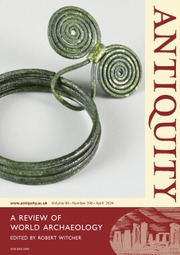Article contents
Early Neolithic plant exploitation in north-western China: archaeobotanical evidence from Beiliu
Published online by Cambridge University Press: 10 December 2024
Abstract

China was a centre for early plant domestication, millets in the north and rice in the south, with both crops then spreading widely. The Laoguantai Culture (c. 8000–7000 BP) of the middle Yellow River region encompasses a crucial stage in the transition from hunting and gathering to farming, yet its subsistence basis is poorly understood. The authors present archaeobotanical data from the site of Beiliu indicating that farmers exploited a variety of wild and cultivated plants. The predominance of broomcorn millet accords with other Neolithic cultures in northern China but the presence of rice—some of the earliest directly dated examples—opens questions about the integration of rice cultivation into local subsistence strategies.
- Type
- Research Article
- Information
- Copyright
- Copyright © The Author(s), 2024. Published by Cambridge University Press on behalf of Antiquity Publications Ltd
References
- 2
- Cited by


